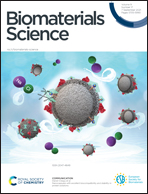A 3D cell printing-fabricated HepG2 liver spheroid model for high-content in situ quantification of drug-induced liver toxicity†
Abstract
3D spheroid cultures are attractive candidates for application in in vitro drug-induced hepatotoxicity testing models to improve the reliability of biological information obtainable from a simple 2D culture model. Various 3D spheroid culture models exist for hepatotoxicity screening, but quantitative assays of spheroid response in situ are still challenging to achieve with the current 3D liver toxicity platforms. In this study, we developed a 3D printing-based HepG2 liver spheroid culture model for in situ quantitative evaluation and high-content monitoring of drug-induced hepatotoxicity. HepG2 liver spheroids grown in mini-fabricated hydrogel constructs using a 3D bioprinter were used to obtain the EC50 values and to measure the multi-parametric hepatotoxic effects, including mitochondrial permeability transition (MPT), cytosolic calcium levels, and apoptosis. Interestingly, the average fluorescence intensities of apoptotic and cell death markers, calculated for out-of-focus and in-focus spheroids, increased proportionally as a function of the drug concentration, allowing for the determination of the EC50 values. In addition, 3D HepG2 spheroids were more resistant to nefazodone-induced MPT than 2D HepG2 cells, indicating that the gelatin/alginate hydrogel culture system provides enhanced resistance to hepatotoxic drugs. The drug response of HepG2 liver spheroids was also found to be unrelated to the spheroid size. These results demonstrate that the present 3D cell-printing-based embedded HepG2 liver spheroid platform is a promising approach for screening and characterizing drug-induced hepatotoxicity.



 Please wait while we load your content...
Please wait while we load your content...